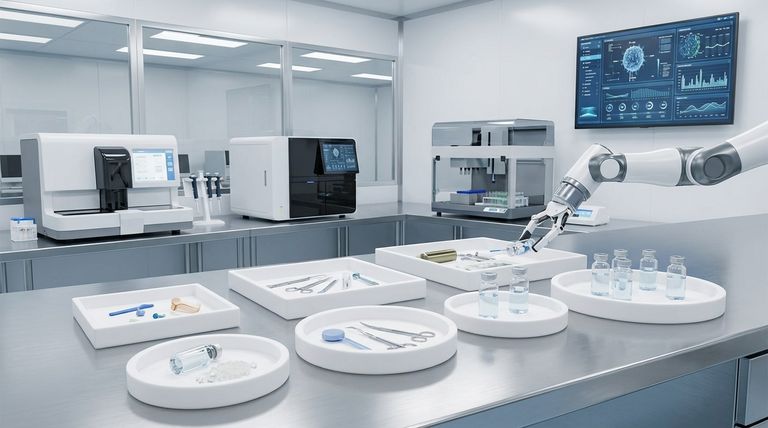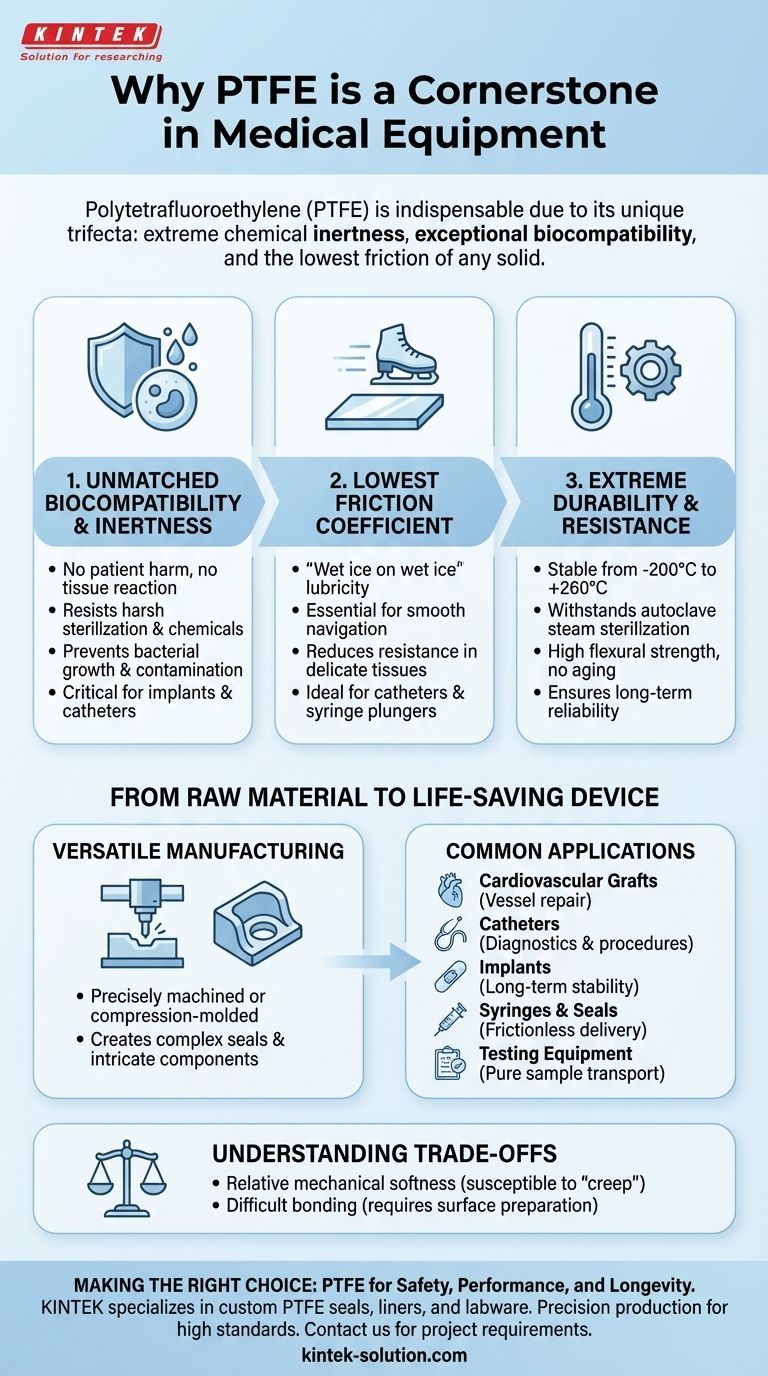Polytetrafluoroethylene (PTFE) is a cornerstone material in modern medical equipment due to its unique combination of three core properties: extreme chemical inertness, exceptional biocompatibility, and the lowest coefficient of friction of any known solid. This trifecta of traits makes it uniquely suited for devices that must function reliably and safely within the human body or in sterile laboratory environments.
The central reason PTFE is trusted in medicine is its profound non-reactivity. It will not degrade from contact with bodily fluids or harsh sterilization chemicals, and its incredibly slick surface prevents tissue adhesion and bacterial growth, ensuring both patient safety and device integrity.

The Pillars of PTFE's Medical Value
To understand why PTFE is so prevalent, we must examine the specific properties that solve critical challenges in medical device engineering.
Unmatched Biocompatibility and Chemical Inertness
The first and most important requirement for any material used in a medical device is that it must not harm the patient.
PTFE is profoundly biocompatible and chemically inert. It does not react with bodily fluids, tissue, or bone, which prevents rejection and minimizes inflammation.
This inertness also means it can withstand aggressive sterilization methods and resist a vast range of chemicals used in medical procedures, ensuring the material itself does not become a source of contamination. Its purity and resistance to bacterial growth are critical for applications like catheters used in cardiac surgery.
The Lowest Friction of Any Solid Material
Many medical devices require components that can slide past one another or through sensitive biological tissues with minimal resistance.
PTFE has an extremely low coefficient of friction, often compared to wet ice on wet ice. This inherent lubricity is not a coating; it is a fundamental property of the material.
This makes it the ideal choice for applications like catheters, which must navigate delicate blood vessels, and syringe plungers, which need to move smoothly for precise fluid delivery.
Extreme Durability and Resistance
Medical devices must perform flawlessly under a wide range of conditions, from inside the body to the high temperatures of an autoclave.
PTFE boasts a vast operating temperature range (from -200°C to +260°C), allowing it to remain stable during steam sterilization.
Furthermore, it exhibits high flexural strength and does not become brittle or degrade over time, a property known as resistance to aging. This ensures the long-term reliability of implants, grafts, and other critical components.
From Raw Material to Life-Saving Device
A material's theoretical properties are only useful if it can be effectively manufactured into a finished product.
Versatility in Manufacturing
PTFE's value is enhanced by its workability. It can be precisely machined from stock rods and tubes or compression-molded into complex shapes.
This allows engineers to create highly specific components, such as seals for medical pumps or intricate parts for testing equipment, tailored to exact specifications.
Common Medical Applications
The practical benefits of PTFE are evident in its widespread use across the medical field:
- Cardiovascular Grafts: Used to repair or replace diseased vessels.
- Catheters: For diagnostics and minimally invasive procedures.
- Implants: Its inertness makes it suitable for certain long-term implants.
- Syringes and Seals: Ensures frictionless movement and hygienic seals.
- Testing Equipment: Used in sample transport mechanisms where purity is essential.
Understanding the Trade-offs
While PTFE's properties are exceptional, no single material is perfect for every situation. As an objective advisor, it's important to understand its limitations.
Relative Mechanical Softness
Compared to metals or high-performance polymers like PEEK, PTFE is a relatively soft material. It can be susceptible to "creep," or deformation under sustained pressure.
Engineers must account for this by designing components where its incredible lubricity and inertness are the primary requirements, rather than high structural strength.
Difficulty in Bonding
PTFE's non-stick surface, a major advantage, also makes it very difficult to bond to other materials using conventional adhesives.
Specialized surface preparation techniques, such as chemical etching, are required to create a bondable surface, which can add complexity and cost to the manufacturing process.
Making the Right Choice for Your Application
Selecting PTFE is a strategic decision based on the primary goal of the medical device.
- If your primary focus is patient safety and infection control: PTFE's inertness, purity, and resistance to bacterial growth make it the definitive choice.
- If your primary focus is smooth mechanical performance: Its unparalleled low coefficient of friction is essential for any application involving sliding parts or passage through tissue.
- If your primary focus is device longevity and reliability: Its resistance to chemicals, high-temperature sterilization, and aging ensures consistent performance over time.
Ultimately, PTFE's unique fusion of properties makes it an indispensable material for advancing medical technology and improving patient outcomes.
Summary Table:
| Key Property | Benefit in Medical Equipment |
|---|---|
| Biocompatibility & Chemical Inertness | Prevents tissue reaction, withstands sterilization, and resists bacterial growth. |
| Lowest Coefficient of Friction | Enables smooth movement for catheters, syringes, and sliding components. |
| Extreme Temperature Resistance | Stable from -200°C to +260°C, ideal for autoclave sterilization. |
| Durability & Aging Resistance | Ensures long-term reliability for implants, grafts, and reusable devices. |
Need high-precision PTFE components for your medical devices? At KINTEK, we specialize in manufacturing custom PTFE seals, liners, labware, and more for the semiconductor, medical, and laboratory industries. Our expertise in precision production—from prototypes to high-volume orders—ensures your devices meet the highest standards of safety and performance. Contact us today to discuss your project requirements!
Visual Guide

Related Products
- Custom PTFE Parts Manufacturer for Teflon Containers and Components
- Custom PTFE Parts Manufacturer for Teflon Parts and PTFE Tweezers
- Custom PTFE Measuring Cylinders for Advanced Scientific and Industrial Applications
- Custom PTFE Teflon Balls for Advanced Industrial Applications
- Custom PTFE Sleeves and Hollow Rods for Advanced Applications
People Also Ask
- What is the working temperature range of PTFE? Master Extreme Heat and Cryogenic Applications
- When and by whom was PTFE discovered? A Tale of Accidental Innovation
- Why is PTFE considered a significant discovery? A Material That Revolutionized Industry
- Why is dimensional stability a concern when machining PTFE? Ensure Accurate, Stable PTFE Components
- What is the temperature range that PTFE can withstand? From -200°C to +260°C for Demanding Applications



















